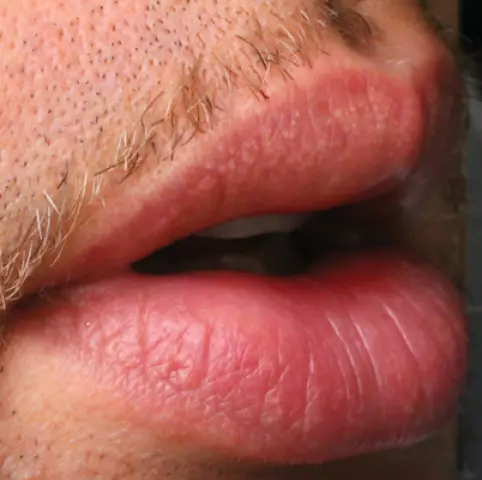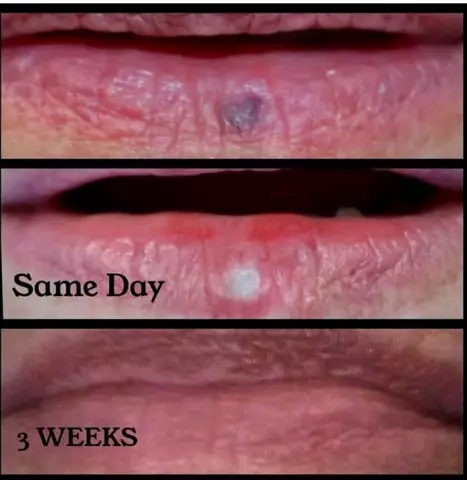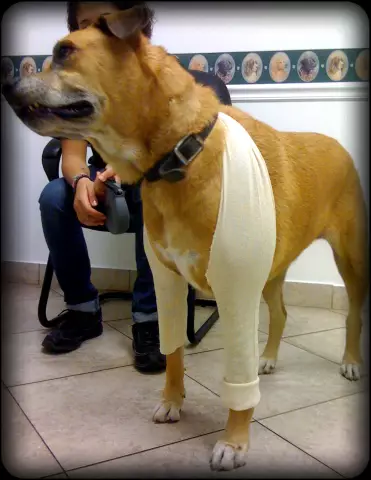- Author Rachel Wainwright [email protected].
- Public 2023-12-15 07:39.
- Last modified 2025-11-02 20:14.
Fordyce granules
What it is
Fordyce granules or seborrheic cysts are called sebaceous glands appearing in the form of light acne on the skin of the genitals (labia, penis), in the groin, on the nipples, in the lips, on the mucous membrane of the mouth.

The name of the granules comes from the name of the scientist JA Fordyce, who described these cysts in 1896.
Fordyce granules do not harm human health, are not transmitted by any type of contact (including sexual contact) and are generally considered a variant of the norm. In most cases, patients seek help only if seborrheic cysts are a cosmetic defect.
Causes of the appearance of Fordyce granules
Until now, the reasons for Fordyce granules are not quite clear.
There is no connection with seborrhea either; the name "seborrheic cysts" is rather a translation defect. It would be more correct to call Fordyce's granules cysts of the sebaceous glands. With seborrhea in patients, a change in the composition of sebum is observed, which leads to blockage of the sebaceous gland duct and the formation of a cyst, similar in appearance to Fordyce granules.
Puberty usually gives rise to seborrheic cysts. The main opinion of scientists is that the reason for Fordyce granules is that the sebaceous glands in these people are located somewhat ectopically (closer than normal, to the upper layer of the dermis and epidermis) or abnormally: on the border of the lips, oral mucosa, etc. … A child from birth has features of the structure and location of the sebaceous glands. During puberty (13-17 years) under the influence of sex hormones (mainly androgens - male sex hormones), the activity of the sebaceous glands increases: sebum production increases, which leads to the visible appearance and is the cause of Fordyce granules.
Also, this group of people has hyperplasia of the ducts of the sebaceous glands. In this connection, cysts are more often formed in them (due to narrowing of the lumen of the duct and obturation of it with sebum). The secretion of the sebaceous gland is not excreted, but accumulates inside the cyst, which leads to an increase in the size of the Fordyce granule and a visible cosmetic defect.
What Fordyce granules look like
Fordyce granules look like small (about 1-2 mm) yellowish specks or yellow-white papules (small nodules) located near the border of the lips, on the mucous membrane of the oral cavity, in the area of the penis shaft, or on the skin of the labia majora. Cysts are painless and often numerous. When pressed on the granules, a small amount of thick yellow-white contents may be released, after which small-point bleeding occurs with the formation of a hematoma around the previous element.
Varieties of Fordyce granules
There are 2 types of Fordyce granules:
- pearlescent papules of the penis;
- Fox-Fordyce disease.
Pearlescent papules of the penis are a variant of the norm. According to different authors, they are found in 30% of young men. They are not harmful to health, are not sexually transmitted, and do not cause complications. In medicine, this problem has been little studied due to the ignorance of doctors about the presence of this manifestation. No effective treatment suggested.
The reason for the appearance of this type of Fordyce granules is also not clear. Some authors consider the cause of excessive proliferation of the epithelium of the excretory ducts of the penis glands. Others are inclined to believe about fibroplastic proliferation of epithelial areas of the glans penis.
Pearlescent papules of the penis appear during puberty and indicate a sharp increase in androgens in the blood. Among the peoples practicing circumcision, the frequency of the formation of these papules is extremely low. This is due to the fact that an increased amount of secretion and smegma, irritating due to their physicochemical properties, the epithelium of the penis and causing fibroplastic proliferation (proliferation), is more easily excreted during hygiene procedures.
Fox-Fordyce disease is an analogue of pearlescent papules, only in women. Her clinic is absolutely identical to the clinic of pearlescent papules of the penis. The lesion is localized in the apocrine sweat glands and is associated (to some extent) with the genitourinary apparatus. Endocrine origin is assumed. Localization of the rash: on the pubis, in the armpits, on the perineum, on the labia majora and around the nipples. It manifests itself more often as mild itching of the skin, aggravated during menstruation. The course of the disease is long, often spontaneous resolution occurs by the age of 40.
What is the need to differentiate Fordyce granules
Fordyce granules, as well as their varieties (pearlescent papules of the penis and Fox-Fordyce disease) must be distinguished from:
- molluscum contagiosum;
- neurodermatitis;
- lichen planus;
- chronic focal eczema.
No additional diagnostic methods for making a diagnosis other than an external examination and exclusion of other diseases are not required.
Fordyce granule treatment
At the moment, all information about the successful treatment of Fordyce granules is contradictory and unconfirmed.
Jojoba oil and Retin-A cream are used. When applied, fresh Fordyce granules are removed and new ones prevented.

Old Fordyce granules are treated more successfully by laser cauterization: electrocoagulation or cryotherapy. Surgical removal of Fordyce granules is practically not used, but it is the most radical method. Self-removal of Fordyce granules by extrusion is absolutely unacceptable. Such "treatment" can lead to the formation of inflammation with further scarring of the skin.
Around the border of the lips, cosmetic treatment of Fordyce granules consists in permanent tattooing, because in some cases, this localization is a cosmetic defect.
By the age of 30, most elements lose their brightness and bulge, become less noticeable. This is due to the extinction of the activity of the sebaceous glands and a decrease in the level of sex hormones.
The information is generalized and provided for informational purposes only. At the first sign of illness, see your doctor. Self-medication is hazardous to health!






